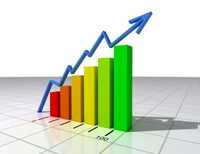| Home | About | Archives | RSS Feed |

@theMarket: Five for Five
 |
It was another good week for the averages with all three indexes chalking up five days of gains in a row. Friday, however, was a mild disappointment thanks to the latest GDP data.
Economists were looking for a first quarter gain of 3 percent in GDP. Instead, the nation's gross domestic product came in at 2.5 percent, but it was still a good number compared to last quarter's 0.4 percent growth. The stock markets, however, have proven that they care less about growth and more about how much and how long the Fed's monetary easing will continue.
In this goldilocks market, good economic data is good news for stocks but also are disappointing economic numbers. I know that sounds crazy, but there is certain logic to this madness.
The Federal Reserve has promised to continue stimulating the economy until the unemployment rate drops by another percentage point or two. In order to achieve that target, the economy must continue to grow and grow at an increasing rate. So, according to the typical investor's logic, disappointing data simply means that the Fed will need to keep pumping money into the economy, which is good for stocks. Of course, if the numbers turn really sour and GDP drops precipitously then all bets are off. But 2.5 percent growth is not too hot or too cold and just enough to insure that the money keeps flowing into the stock markets.
All week Europe has rallied as well. There is a building consensus over there that economies both big and small need further stimulus and possibly an interest rate cut by the European Central Bank. "Austerity," both here and abroad, appears to be becoming a bad word for all but a few die-hard right-wing economists and their followers who we will call "Austerians."
Clearly austerity has not worked in Europe, has not worked in this country, and has not worked in Japan. As a result, what we are seeing is across-the-board movement toward further easing. I, among others, have been arguing for this since 2009.
Of course, those opposed have insisted that unless governments reduced their deficits and restored confidence, simply spending more would only increase debt loads (which are already at record highs). And once countries crossed a theoretical debt-to-GDP threshold, (thought to be 90 percent) they would experience a permanent slowdown in growth as well as hyperinflation.
This argument has raged on for five years with the austerity gang here in America gaining the upper hand this year. Thanks to the Sequester, we are now experiencing the impact of across-the-board cuts at a time when our economy needs spending, not cuts. Oh, and by the way, that theoretical line in the sand that the Austerians insist would sink the economy (based on an academic paper on the subject), was found to contain a mathematical error. Once the error was corrected, the 90 percent debt-to-GDP statistic went up in smoke.
Now, simply because the facts do not square with the Austerians' argument does not mean that they will cease and desist. There is too much at stake to quit now. After all, an entire wing of the Republican Party has been born again (and elected) under this theme. They will stubbornly insist on being right in the face of economic reality until we stop listening to them. In the meantime, despite our debt load and free-spending ways the stock market continues to go higher and higher. Imagine that.
Bill Schmick is registered as an investment adviser representative with Berkshire Money Management. Bill’s forecasts and opinions are purely his own. None of the information presented here should be construed as an endorsement of BMM or a solicitation to become a client of BMM. Direct inquires to Bill at 1-888-232-6072 (toll free) or email him at Bill@afewdollarsmore.com.

